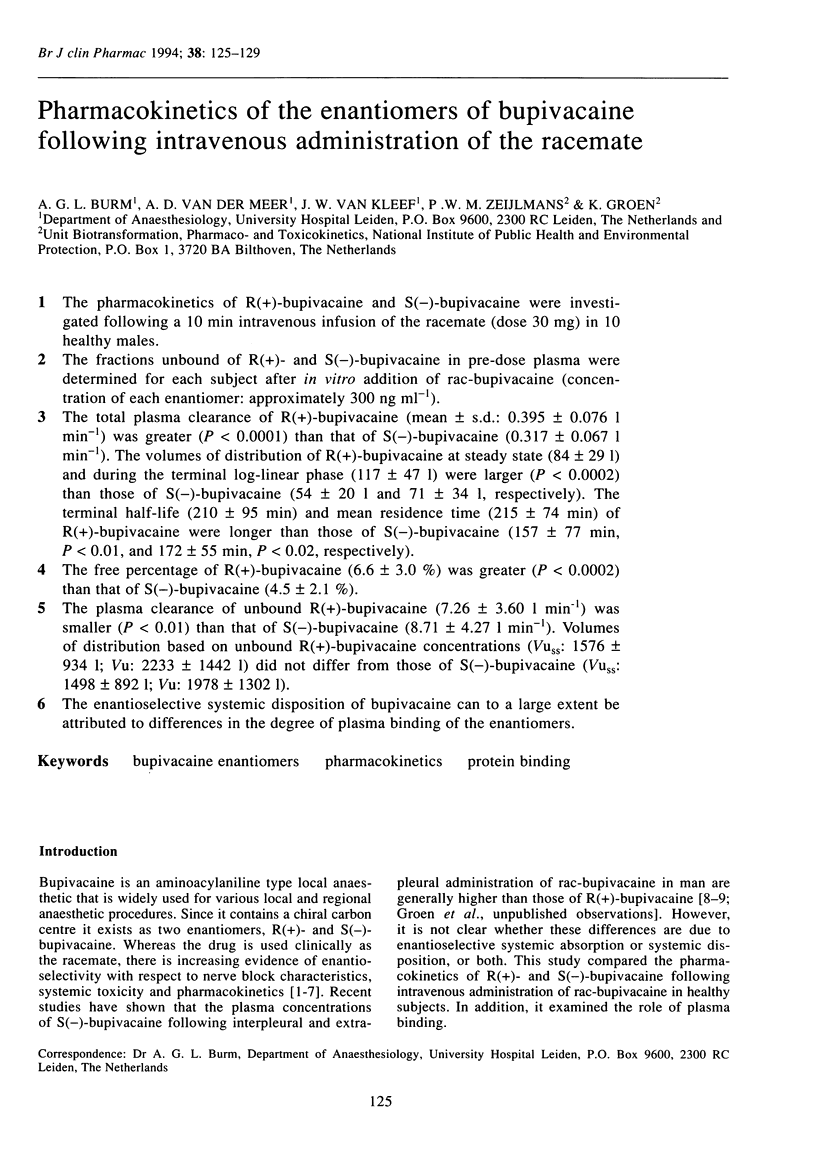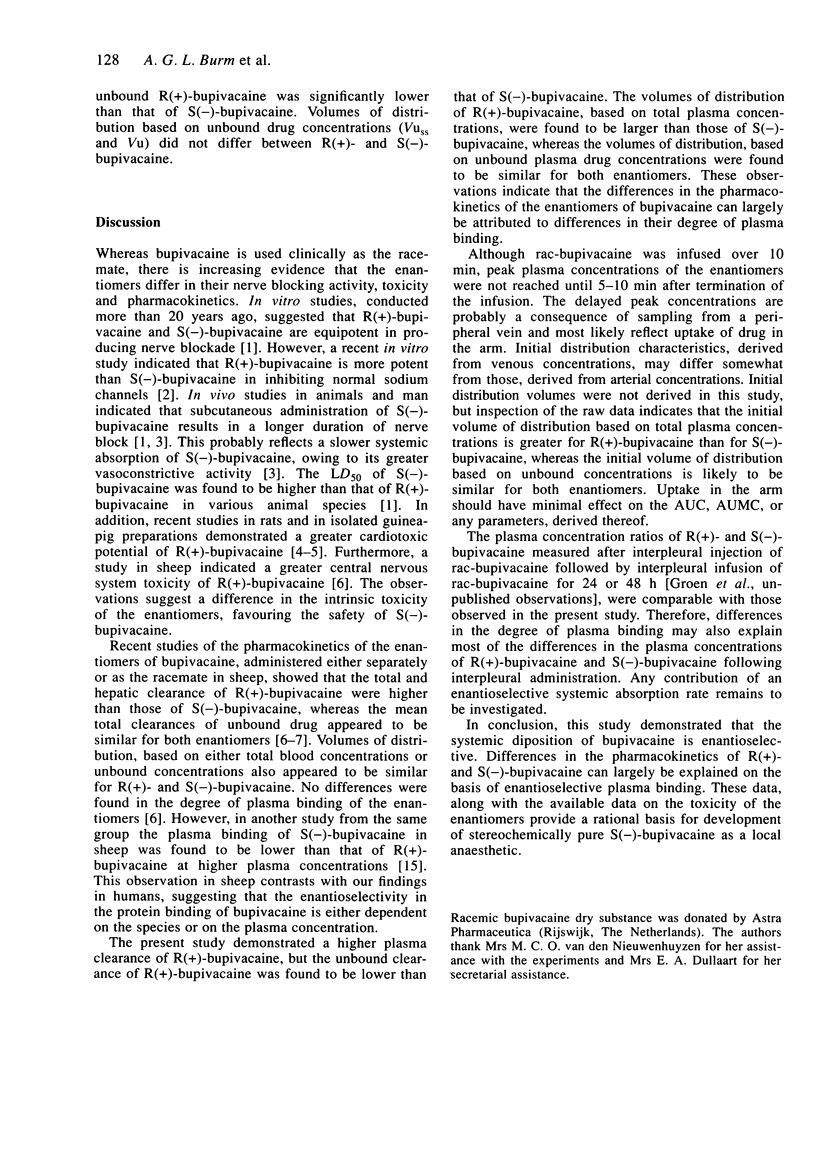Abstract
1. The pharmacokinetics of R(+)-bupivacaine and S(-)-bupivacaine were investigated following a 10 min intravenous infusion of the racemate (dose 30 mg) in 10 healthy males. 2. The fractions unbound of R(+)- and S(-)-bupivacaine in pre-dose plasma were determined for each subject after in vitro addition of rac-bupivacaine (concentration of each enantiomer: approximately 300 ng ml-1). 3. The total plasma clearance of R(+)-bupivacaine (mean +/- s.d.: 0.395 +/- 0.076 l min-1) was greater (P < 0.0001) than that of S(-)-bupivacaine (0.317 +/- 0.067 l min-1). The volumes of distribution of R(+)-bupivacaine at steady state (84 +/- 29 l) and during the terminal log-linear phase (117 +/- 47 l) were larger (P < 0.0002) than those of S(-)-bupivacaine (54 +/- 20 l and 71 +/- 34 l, respectively). The terminal half-life (210 +/- 95 min) and mean residence time (215 +/- 74 min) of R(+)-bupivacaine were longer than those of S(-)-bupivacaine (157 +/- 77 min, P < 0.01, and 172 +/- 55 min, P < 0.02, respectively). 4. The free percentage of R(+)-bupivacaine (6.6 +/- 3.0 %) was greater (P < 0.0002) than that of S(-)-bupivacaine (4.5 +/- 2.1 %). 5. The plasma clearance of unbound R(+)-bupivacaine (7.26 +/- 3.60 1 min-1) was smaller (P < 0.01) than that of S(-)-bupivacaine (8.71 +/- 4.27 l min-1). Volumes of distribution based on unbound R(+)-bupivacaine concentrations (Vuss: 1576 +/- 934 l; Vu: 2233 +/- 1442 l) did not differ from those of S(-)-bupivacaine (Vuss: 1498 +/- 892 l; Vu: 1978 +/- 1302 l). 6. The enantioselective systemic disposition of bupivacaine can to a large extent be attributed to differences in the degree of plasma binding of the enantiomers.
Full text
PDF




Selected References
These references are in PubMed. This may not be the complete list of references from this article.
- Aberg G. Toxicological and local anaesthetic effects of optically active isomers of two local anaesthetic compounds. Acta Pharmacol Toxicol (Copenh) 1972;31(4):273–286. [PubMed] [Google Scholar]
- Aps C., Reynolds F. An intradermal study of the local anaesthetic and vascular effects of the isomers of bupivacaine. Br J Clin Pharmacol. 1978 Jul;6(1):63–68. doi: 10.1111/j.1365-2125.1978.tb01683.x. [DOI] [PMC free article] [PubMed] [Google Scholar]
- Berrisford R. G., Sabanathan S., Mearns A. J., Clarke B. J., Hamdi A. Plasma concentrations of bupivacaine and its enantiomers during continuous extrapleural intercostal nerve block. Br J Anaesth. 1993 Feb;70(2):201–204. doi: 10.1093/bja/70.2.201. [DOI] [PubMed] [Google Scholar]
- Denson D. D., Behbehani M. M., Gregg R. V. Enantiomer-specific effects of an intravenously administered arrhythmogenic dose of bupivacaine on neurons of the nucleus tractus solitarius and the cardiovascular system in the anesthetized rat. Reg Anesth. 1992 Nov-Dec;17(6):311–316. [PubMed] [Google Scholar]
- Groen K., Zeijlmans P. W., Burm A. G., van Kleef J. W. Improved clean-up procedure for the high-performance liquid chromatographic assay of bupivacaine enantiomers in human plasma and ultrafiltrate in the nanogram per milliliter range. J Chromatogr B Biomed Appl. 1994 Apr 22;655(1):163–166. doi: 10.1016/0378-4347(94)00101-4. [DOI] [PubMed] [Google Scholar]
- Lee-Son S., Wang G. K., Concus A., Crill E., Strichartz G. Stereoselective inhibition of neuronal sodium channels by local anesthetics. Evidence for two sites of action? Anesthesiology. 1992 Aug;77(2):324–335. doi: 10.1097/00000542-199208000-00016. [DOI] [PubMed] [Google Scholar]
- Lee E. J., Ang S. B., Lee T. L. Stereoselective high-performance liquid chromatographic assay for bupivacaine enantiomers. J Chromatogr. 1987 Sep 4;420(1):203–206. doi: 10.1016/0378-4347(87)80174-3. [DOI] [PubMed] [Google Scholar]
- Mather L. E. Disposition of mepivacaine and bupivacaine enantiomers in sheep. Br J Anaesth. 1991 Sep;67(3):239–246. doi: 10.1093/bja/67.3.239. [DOI] [PubMed] [Google Scholar]
- Perrier D., Mayersohn M. Noncompartmental determination of the steady-state volume of distribution for any mode of administration. J Pharm Sci. 1982 Mar;71(3):372–373. doi: 10.1002/jps.2600710332. [DOI] [PubMed] [Google Scholar]
- Riegelman S., Collier P. The application of statistical moment theory to the evaluation of in vivo dissolution time and absorption time. J Pharmacokinet Biopharm. 1980 Oct;8(5):509–534. doi: 10.1007/BF01059549. [DOI] [PubMed] [Google Scholar]
- Rutten A. J., Mather L. E., McLean C. F. Cardiovascular effects and regional clearances of i.v. bupivacaine in sheep: enantiomeric analysis. Br J Anaesth. 1991 Sep;67(3):247–256. doi: 10.1093/bja/67.3.247. [DOI] [PubMed] [Google Scholar]
- Rutten A. J., Mather L. E., Plummer J. L., Henning E. C. Postoperative course of plasma protein binding of lignocaine, ropivacaine and bupivacaine in sheep. J Pharm Pharmacol. 1992 Apr;44(4):355–358. doi: 10.1111/j.2042-7158.1992.tb03620.x. [DOI] [PubMed] [Google Scholar]
- Vanhoutte F., Vereecke J., Verbeke N., Carmeliet E. Stereoselective effects of the enantiomers of bupivacaine on the electrophysiological properties of the guinea-pig papillary muscle. Br J Pharmacol. 1991 May;103(1):1275–1281. doi: 10.1111/j.1476-5381.1991.tb12336.x. [DOI] [PMC free article] [PubMed] [Google Scholar]


